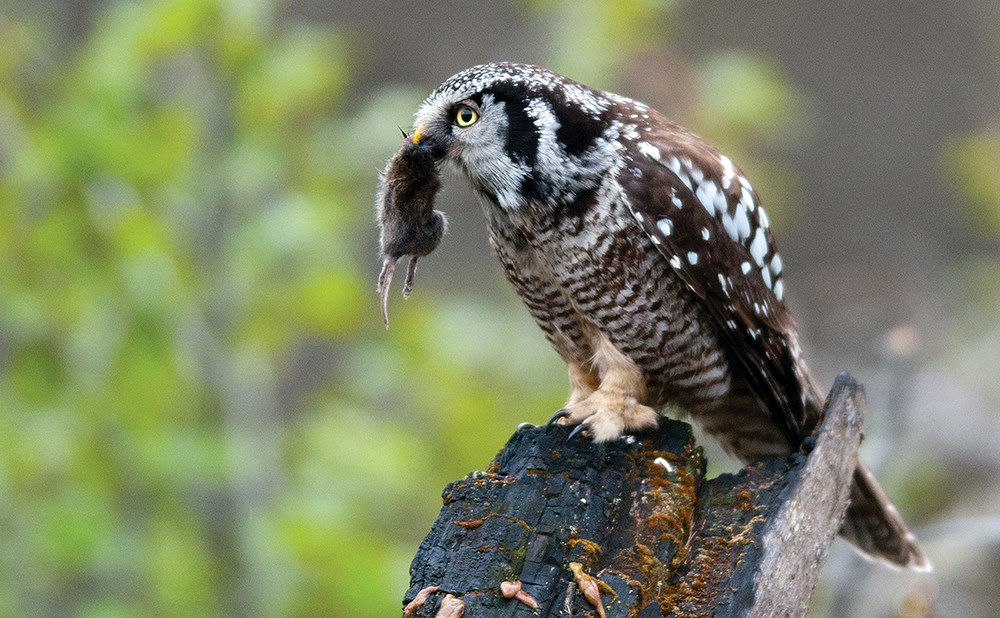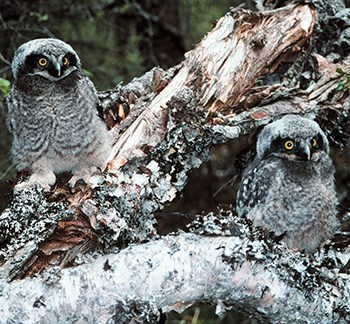Last updated: October 5, 2017
Article
Northern Hawk Owl Resource Brief
Background Information

Chris Peterson
Threats
In Montana, northern hawk owls are listed as a species of concern and considered to be potentially at risk due to limited or declining numbers, range, and/or habitat. Because there is still little known of the northern hawk owl life cycle, population size, and reproduction, they are also listed as a species of highest inventory need in Montana. Recently burned areas are thought to be critical to their reproductive success as they provide nesting habitat and abundant food, both crucial resources for breeding. It is unclear whether changes in fire regimes, due to a changing climate, will benefit northern hawk owls. More frequent and intense fires may result in a greater amount of suitable habitat, but a rich mosaic of burned and unburned forest is required for their success. Loosing this habitat diversity may impact prey abundance for many species of fire-associated birds and affect their population stability.
The northern hawk owl is one of the least studied owl species in North America. Found in boreal forests throughout the northern hemisphere, hawk owls live throughout most of Alaska and Northern Canada, and are occasionally found in northern portions of the contiguous United States. These medium-sized owls are noted for being bold, even in the presence of humans, and are defined by their hawk-like appearance and mannerisms. Unique for their long tails and pointed wings, hawk owls are often seen during the day perched on treetops or snags (standing dead trees) in search of prey. They have been found nesting in both natural tree cavities and vacated woodpecker holes. Much of the hawk owl’s diet consists of small mammals, such as voles and shrews, but they have been known to eat larger prey species, including snowshoe hares and grouse.
Northern hawk owls are one of several bird species found in recently burned forests. Snags provide nest sites and foraging opportunities for them as well as for woodpeckers, mountain blue birds, and flycatchers. Black-backed woodpeckers forage for beetle larvae under the bark of dying, or recently dead trees of post-burn areas. The entirely black back of these woodpeckers provides excellent camouflage, making them difficult to detect while foraging. Mountain blue birds use postburn areas to hunt insects on bare ground, newly grown vegetation, or from the air. Northern hawk owls are thought to be nomadic and occupy recently burned areas to take advantage of exploding populations of small mammals, which thrive on new seed production.
Status and Trends
Northern hawk owls are not a global species of concern due to their wide distribution throughout the northern hemisphere. Currently, their populations are considered stable in Alberta and British Columbia. The northern hawk owl is listed as a Montana species of concern, but since so little is known about their life cycle, population size, and reproduction, this listing has not resulted in specific conservation measures.
Only four northern hawk owl nests were documented in Glacier National Park from 1989-2005, following the 1988 Red Bench Fire. Owls were seen again in 2005, when four pairs and three nests were recorded in the North Fork area. These sightings occurred in one of the post-burn areas from the 2003 fire season. Although research is ongoing, it has been proposed that northern hawk owls favor recently burned areas due to the plentiful nesting habitat and prey abundance, both crucial for successful breeding.
In 2006, the Owl Research Institute began to study northern hawk owls in Glacier. With the exception of 2008, they have documented successful breeding annually between 2005 and 2015. Initially, the owls nested each year in areas burned in 2003 on Glacier’s west side, but no nests or fledglings were documented in 2015. On the east side of the park, one nest was found during the 2015 breeding season in the 2006 Red Eagle Fire postburn area, possibly supporting the idea that northern hawk owls prefer recently burned areas for breeding. This research has provided some of the only long-term evidence of successful breeding of northern hawk owls in the contiguous United States. In addition to documenting nesting, researchers have used mist nets to capture, weigh, measure, sex, age, and band nearly 70 individual hawk owls. During the study period, only one hawk owl has been recaptured, bolstering the idea that northern hawk owls are a nomadic species.

NPS
Management Strategy
It is the park policy not to clear post-burn areas, unless snags pose a safety hazard to roads, trails, or campgrounds. This policy differs from other resource management agencies which commonly log postburn areas. Glacier’s approach minimizes additional disturbance after a fire and allows post-burn sites to revegetate naturally, leaving vital wildlife habitat intact.
Due to resource limitations, park staff do not regularly survey or monitor post-burn sites. However, partnering researchers provide valuable information about how different birds use post-burn areas during different phases of the forest’s regrowth. The park policy of noninterference after a fire provides critical habitat for fireassociated birds and may contribute to the high number of northern hawk owls that have been documented in Glacier. As our warming climate causes fires to become more frequent and intense, the composition of post-burn ecosystems will inevitably change, but it is difficult to say how this will impact the bird species that depend on these areas for habitat and food.
Resources for More Information
Glacier National Park Staff
- Lisa Bate, Wildlife Biological Science Technician
- Tara Carolin, Director, Crown of the Continent Research Learning Center
Documents and web sites
- Owl Research Institute – www.owlinstitute.org/research
- Montana Heritage Field Guide – fieldguide.mt.gov/speciesDetail.aspx?elcode=ABNSB07010
- Cornell Ornithology – www.allaboutbirds.org/guide/Northern_Hawk_Owl/id
The Crown of the Continent Research Learning Center
Phone: 406-888-5827; Email: melissa_sladek@nps.gov
Website: www.nps.gov/rlc/crown
Downloadable pdf
Northern Hawk Owl Resource Brief (206 KB)
